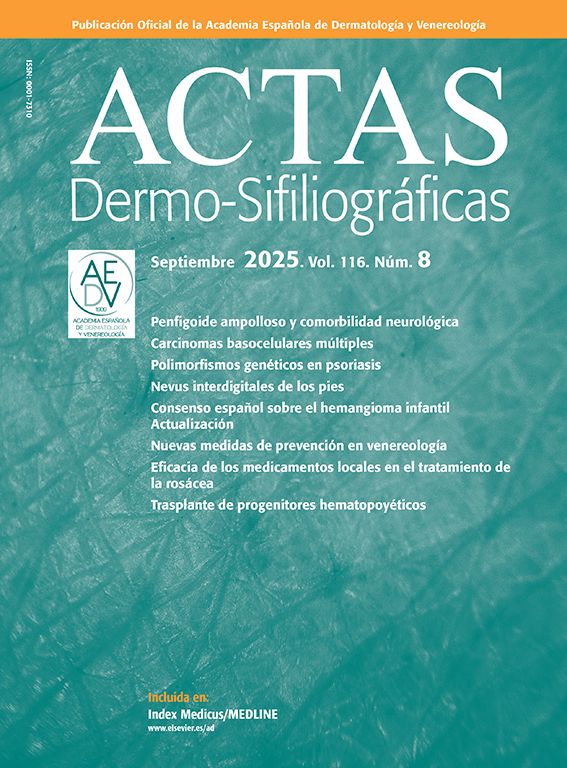On May 1st, 2024 Pena Perez et al. published an insightful manuscript on the progress made in dermatology in Spain across reports published in 5 prestigious journals from 2018 to 2019.1
- 1.
While the authors effectively highlighted the Spanish productivity in 5 journals, interpreting the progress made in Spain in dermatological research remains unclear. Comparing the contributions made by Spain with other countries or regions would have provided valuable context and a better evaluation of its global significance.
- 2.
While data from 2018 and 2019 offers a brief snapshot, it lacks the long-term perspective needed to assess the dermatology research trajectory in Spain.
- 3.
Analyzing the top 100 most cited papers from these journals could have offered deeper insights into the impact of Spanish research.
The objective of the present note is to present the academic performance of Spanish scholars in the same top 5 dermatology journals: The Journal of the American Academy of Dermatology (JAAD), JAMA Dermatology, The Journal of Investigative Dermatology, The Nritish Journal of Dermatology (BJD), and The Journal of the European Academy of Dermatology and Venereology (JEADV) using an open timeframe. This approach aims to provide a more comprehensive analysis of the contributions made by Spain to the dermatology field over an extended period of time.
Global approachA total of 67,128 publications (Fig. 1A) were identified across 5 leading dermatology journals. These publications included a total of 63,039 articles and 4089 reviews, reflecting significant contributions to the dermatology field over more than a century.The Journal of the American Academy of Dermatology (JAAD) published the highest number of articles, totaling 20,580, followed closely by The British Journal of Dermatology (BJD) with 20,554 publications. The Journal of Investigative Dermatology (JID) contributed 18,003 publications, while The Journal of the European Academy of Dermatology and Venereology (JEADV) accounted for 6189 articles. The smallest contribution came from JAMA Dermatology, with 1802 published articles.
The temporal analysis showed publications dating back to 1892, with 15 articles that year. From 1892 to 1920, annual outputs went from 14 up to 57 articles. Mid-20th century growth saw over 100 articles each year by 1935 and 200 by 1952. Significant increases followed, exceeding 500 articles in 1979 and 1000 by 1989. By 2024, annual publications peaked at 2001, highlighting the continuous expansion of dermatological research and the journals’ role in knowledge dissemination.
The progress made in SpainA total of 2139 Spanish publications (Fig. 1B) were identified across 5 leading dermatology journals. The Journal of the American Academy of Dermatology (JAAD) accounted for the highest number of Spanish contributions, with 695 papers, followed by The Journal of the European Academy of Dermatology and Venereology (JEADV) with 670 publications. TheBritish Journal of Dermatology (BJD) published 468 papers from Spain, while The Journal of Investigative Dermatology (JID) featured a total of 206 articles. The lowest number of publications appeared in JAMA Dermatology, with 100 papers.
In fact, in the stated 5 journals, the United States emerged as the top contributor with 25,351 publications, followed by the United Kingdom (10,588), Germany (5965), France (3840), and Japan (3783). Italy (3049) and The Netherlands (2529) also featured prominently. Spain, with 2139 publications, ranked #8 (based on number of publications) among contributing countries.
Spanish contributions began in 1952 with a single article and remained sporadic until the 1980s, with 1–2 papers being published each year. Output gradually increased, surpassing 10 papers annually by 1989. Significant growth followed, with publications rising from 11 in 1991 up to 43 in 2002. By 2004, annual output exceeded 50 papers, surpassing 80 by 2013 and peaking at 123 in 2024. This steady rise highlights Spain growing presence in dermatological research and prominence among these journals.
The Spanish progress in top 100 most cited papersAmong the top 100 most-cited papers in 5 selected journals, Spain ranked 11th in publication count (6 documents) but only 28th in citations (723), underscoring a notable disparity between productivity and research impact. For instance, Japan and Greece, with similar or fewer documents, achieved 10,053 and 21,853 citations, respectively. Even Norway and Belgium, with only 2 documents each, surpassed Spain with 7876 and 5958 citations.
This suggests Spain's research lacks the global reach or relevance to attract broader attention. Improving collaboration, publishing in high-impact journals, and addressing global issues could enhance visibility and citation impact. Dissemination strategies and international engagement also need further investigation to address this performance gap.
ConclusionsSpain has made notable strides in dermatological research, contributing 2139 publications across 5 leading journals and demonstrating steady progress over decades. However, despite ranking 11th in publications among the top 100 most cited papers, it ranks 28th in citations, which shows limited global impact. Countries with fewer publications often achieve higher citation metrics, highlighting a need to improve research quality, relevance, and visibility.
To bridge this gap, Spain should prioritize international collaborations, focus on high-impact topics, and enhance dissemination strategies aligned with global priorities.
Once again, we wish to thank Peña Pérez et al. for advancing understanding of Spanish dermatological research trends. This note aims to supplement their findings and encourage further exploration in this field.






